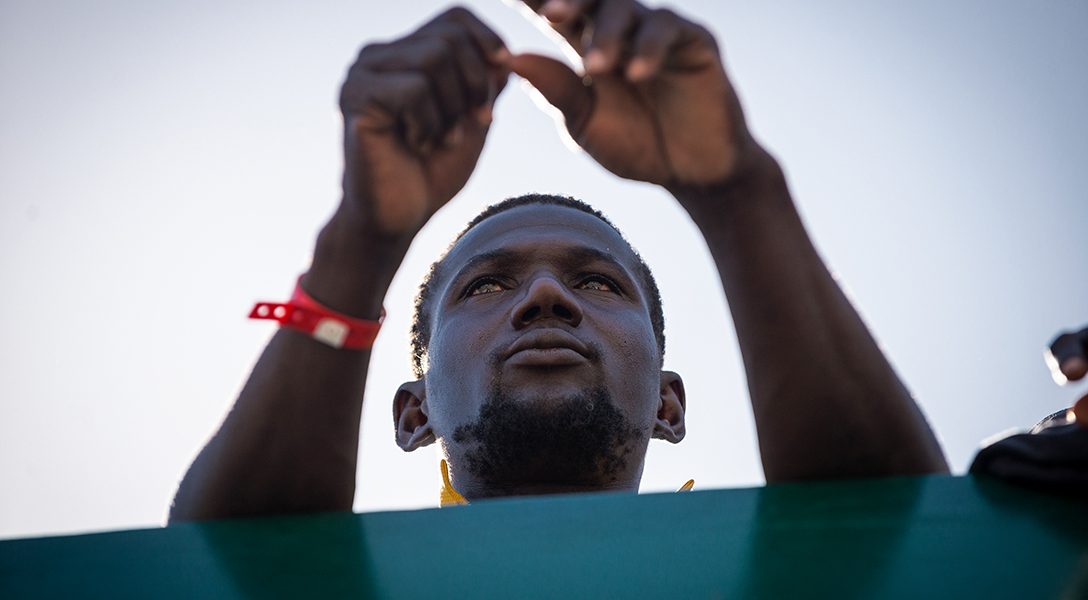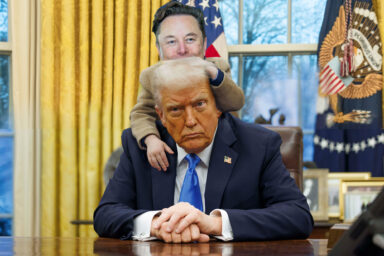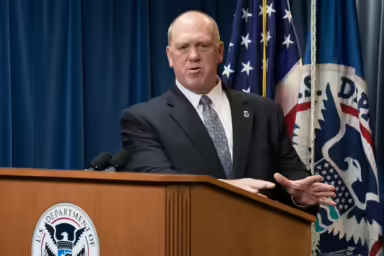In Libya, EU Supports Returning Migrants to a War Zone
Europe Aligns With Trump in Brutal Refugee Policy
EU migration policy is turning deadly. People seeking to reach Europe are drowning at its doorstep or caught in the crossfire of Libya's civil war.
A month of chaos and death has revealed the risks of a European Union (EU) migration policy that pays Libyan militias to intercept migrants — and bans humanitarian rescue ships from saving their lives in the Mediterranean.
Members of rival militias began fighting in the streets of Libya’s capital, Tripoli, on August 26. Rockets and heavy artillery are hitting neighborhoods where migrants are held in detention. Doctors Without Borders (MSF), which treats migrants and refugees in Libya, has been calling for emergency evacuations since September 7.
“Several detention centers in Tripoli are on front lines and thousands of desperate people are still trapped inside. There is a real risk of mass casualties as a result of indiscriminate shelling and artillery fire,” warned Ibrahim Younis, MSF’s head of mission in Libya.
The US Committee for Refugees and Immigrants says they “could starve, die of disease, be shot, or become enslaved by militias or traffickers.”
Many of the people huddled in detention had tried to reach Europe but were intercepted by the Libyan Coast Guard. Tens of thousands of people enter Libya each year hoping to make the short but dangerous sea voyage across the Mediterranean. The EU is paying the Libyan Coast Guard, notorious for links to armed militias and human traffickers, to intercept Europe-bound migrants — an estimated 13,000 in the first eight months of this year — and return them to be locked up in and around the Libyan capital.
So far in 2018, more than 1,700 people have died or gone missing while trying to reach Europe via the Mediterranean, mostly between Libya and Italy.
In the meantime, Italy and Malta have waged an intense campaign against humanitarian organizations (NGOs) that go to sea to rescue migrants. As a result, there are no more NGO boats operating in the central Mediterranean.
The EU’s new strategy has been ruthlessly effective in reducing unwanted arrivals. August saw just 1,300 depart from Libya in an attempt to reach Europe by sea — the lowest summer figure since 2012. Since January, Italy has experienced an 87 percent drop in illegal immigration.
But it comes at a terrible human cost. In September, during the fighting in Tripoli, migrants and refugees departing from Libya for Europe drowned or went missing at the highest rate ever.
(⛔🚢BREAKING) WHATEVER IT TAKES. This September, #migrants departing from #Libya died or went missing at the highest rate EVER recorded.
1 in 10 made it to Europe.
7 in 10 were caught and brought back.1 in 5 died or went missing. 📈👇 pic.twitter.com/0gG19Z2I1u
— Matteo Villa (@emmevilla) October 1, 2018
Some members of the Libyan Coast Guard are suspected of links to people-trafficking networks and ISIS. The EU pays for their training and claims to vet them. But a spokesman admits that the rejects return to work for $150 a month. When the UN Security Council imposed its first-ever sanctions on human traffickers late last year, one of them was a Libyan Coast Guard commander.
The battle for Tripoli that began in late August pits militias claiming to support the UN-backed Government of National Accord (GNA) in western Libya (another government controls eastern Libya) against the Seventh Brigade, a militia located outside Tripoli. A September 4 ceasefire only lasted a few days. A second UN-brokered ceasefire has been in place since September 25.
There is not a single NGO search-and-rescue boat between North Africa and Italy.
The clashes have killed over a hundred people, mostly civilians. Some 25,000 Libyans have fled their homes. ISIS-linked terrorist groups are taking advantage of the chaos to launch attacks on state institutions, putting Libya’s oil recovery at risk. The US is retaliating with airstrikes.
The fighting is over which armed groups control state funds and the country’s vast reserves of oil and gas. Some militias are already extremely powerful, controlling sectors of the government, even whole ministries.
Some of the clashes might also involve people-smuggling militias that are fighting for a share of the booming, EU-funded, anti-smuggling business. A recent investigation by the UN Panel of Experts on Libya reveals that one of the things militias are fighting over is a share of international payments to intercept migrants: “…to gain legitimacy by ostensibly supporting efforts to combat irregular migration and thereby receive technical and material assistance from foreign actors.” The “foreign actors” in question are presumably Italy and the EU.
Libya’s Downward Spiral
.
Libya has been a “shit show” (the words are Barack Obama’s) since the NATO intervention and the death of its dictator Muammar Gaddafi in 2011. The US and its European NATO allies never succeeded in resurrecting a Libyan state with a single capital and government. Hundreds of kidnap gangs and militias have turned human trafficking into an industry and made vast fortunes.
Italy, with EU support, has been pouring millions of taxpayer euros into the Coast Guard, detention centers, and so-called security forces, “large parts [of which] are run or controlled by militias, some deeply involved in the smuggling economy,” according to a recent report on human trafficking. As a result, “a gang notorious for kidnapping and extorting migrants may suddenly be seen running an internationally funded state detention center for migrants.”
Blocking migrants from fleeing war and poverty in the Middle East and Africa has become one of the EU’s top priorities. The EU Commission’s 2016 Agenda on Migration deplores that “the message that migration issues are now at the top of the EU’s external relations priorities has not yet been fully communicated to and appreciated by partners.” The EU cannot “build a wall across the Sahara,” as Trump recently suggested, but it is spending vast sums on border security deals with the governments of Nigeria, Niger, Ethiopia, Senegal, and Mali.
Rather than force families to listen on a cellphone as their loved ones are being tortured, some kidnappers are now sending video clips.
In a break with the past, the aid money is not dependent on respect for human rights and the rule of law: The EU signed a $200 million pact with Sudan’s Al-Bashir — a war criminal wanted internationally for the Darfur genocide — to stop Eritrean and Ethiopian asylum seekers from crossing the country’s northern border with Libya.
Right-wing politicians in Europe tend to call all unauthorized migrants “economic migrants” — even if they are refugees seeking a safe haven from war and persecution — and demand that they be deported. And lawless Libya also blurs the distinction. People who set out from West Africa for the opportunity to work or study in Europe not only risk their lives crossing the Sahara, but also face being kidnapped, tortured, and sold into prostitution or slavery. If they survive and arrive in Europe, they may have faced a more terrible ordeal than a refugee from a war-torn country.
The Trip to Europe Is ‘Deadlier Than Ever’
.
The central Mediterranean is the world’s deadliest migration route. It became more dangerous after the EU stopped dedicating maritime resources to rescuing migrants and refugees at the end of 2014. Humanitarian NGOs moved to fill the void, with some success, until their activities were criminalized and largely suspended.

So far in 2018, more than 1,700 people have died or gone missing while trying to reach Europe via the Mediterranean, mostly between Libya and Italy. Migrants are three times more likely to drown now than those who made the same journey between Libya and Europe in 2015.
Related: Let Them Drown? Italy’s Trump Closes Ports to Refugees
When migrants are rescued, they can remain stranded on their rescue ships for days while EU governments argue over who should take them in.
At the time of this writing, there is not a single NGO search-and-rescue boat between North Africa and Italy. The MV Aquarius, operated by Doctors Without Borders (MSF) and SOS Mediterranee, left the area on September 22 because Italy reportedly pressured Panama to revoke the ship’s maritime flag and registration.
“This announcement condemns hundreds of men, women and children who are desperate to reach safety to a watery grave,” warned MSF and SOS Mediterranee in a statement.
“It feels a bit lonely,” said Benoît Micolon, a Frenchman who pooled his life savings with another pilot this spring to buy a two-seat airplane and fly humanitarian missions between Italy, Libya, and Malta.
When he and one of his fellow Volunteer Pilots (Pilotes Volontaires) spot an overcrowded boat in distress, usually a flimsy rubber dingy full of people with no life jackets, they alert the Maritime Rescue Coordination Center (MRCC) in Rome. But they are often told to contact the MRCC in Libya. “They don’t speak English and, most of the time, they don’t pick up the phone.”
Guantánamo for Migrants
.
Once the Libyan Coast Guard disembarks shipwrecked migrants, they are imprisoned indefinitely in detention centers run by Libya’s Department for Combating Illegal Migration (DCIM). The people are held against their will with no time limit unless they can be evacuated to a third country — either through repatriation or, if they are recognized as refugees, resettlement. In both cases, the process is slow and the numbers very small.
In reality, the centers are “no more than forced labour camps and makeshift prisons,” according to UNICEF. Zeid Ra’ad Al Hussein, former UN Human Rights chief, said his staff found the centers contained “thousands of emaciated and traumatized men, women and children piled on top of each other, locked up in hangars with no access to the most basic necessities, and stripped of their human dignity.” Corrupt detention guards sometimes turn detainees over to one of the kidnap gangs that torture migrants for money and/or sell them as slaves.

There are people of a couple dozen nationalities in the detention centers, according to the UN. Many have fled from the northeast African country of Eritrea. The country is recognized almost universally as one of the most repressive regimes in the world (the “North Korea” of Africa). Ninety percent of Eritreans who manage to reach Europe, mostly through Libya, are granted asylum.
The America Team for Displaced Eritreans says there are 8,000 Eritreans huddled in detention between warring militias. There are reports some have died of starvation while others have escaped and are hiding or living in the streets of Tripoli.
Meron Estefanos, an Eritrean refugee-advocate based in Sweden, negotiates for the release of kidnap victims. “I’m getting more phone calls now because of what is happening in Libya,” she told WhoWhatWhy.
Estefanos describes helping families who have paid ransom “six or seven times” — because their loved ones were intercepted, returned to Libya, and trafficked again. “It’s a Catch 22. Before, when people were being sold, you could buy them out and they could arrive safely somewhere.”
She says Eritreans are spending more time in detention as armed militias branch out from people-smuggling to trafficking and extortion. Kidnappers are turning to social media to contact victims’ families to extract a ransom. Rather than force families to listen on a cellphone as their loved ones are being tortured, some kidnappers are now sending video clips.
Estefanos recently met with a group of unaccompanied minors who have been granted asylum in Sweden. The youngest is 14. Several of them, after being sold “three or four times,” wound up on the frontlines in Tripoli, carrying weapons and running errands for militias in the heat of battle. “Everyone is at war with each other … meanwhile the people who are detained, even the children, are being used in the war,” she said.
A year ago the EU seemed to actually wake up to the horrors that refugees and migrants suffer in Libya. France promised a “concrete military and police initiative on the ground” last November (in a “joint task force” with the African Union) to evacuate migrants trapped in Libya. The pledge came after CNN showed footage of African migrants being auctioned off as slaves for $400 a head. But the “emergency” anti-slavery mission never happened.
Much has changed since then. Mainstream opposition to hardline anti-immigrant politicians is crumbling. Populists and far-right radicals have governed Italy, the Eurozone’s third-largest country, since June. Germany faces internal political challenges from the rising far-right Alternative for Germany (AfD) party.
“What I’m saying today was seen as right or radical-right within the EU three years ago,” said Austrian Chancellor Sebastian Kurz to a TV reporter ahead of an EU summit (September 19–20) in the Austrian alps. Kurz has issued a call for a Rome-Berlin-Vienna “Axis of the Willing” to stop illegal immigration.
Europe’s leaders spent more time during the summit arguing about migration — which countries should accept more asylum seekers and who should pay for them — than about Brexit, the existential threat of the UK’s looming departure from the European Union.
No Way
.
The governments of the European Union seem to be moving inexorably toward greater alignment with the United States and Australia in what Filippo Grandi, UN High Commissioner for Refugees, calls “a growing climate of hostility, xenophobia, and rejection.”
Before the EU’s anti-migrant strategy in Libya, it was Australia that arguably had the world’s harshest anti-immigration policy. An “exercise in cruelty,” it involves detaining asylum seekers indefinitely in privately-run offshore detention centers on the Pacific islands of Nauru and Manus.
Human rights groups have tried to discourage the EU from looking to Australia for inspiration, pointing out that Australia’s “asylum model” — No Way — violates international law and is astronomically expensive.
But Italy’s most powerful politician, Deputy Prime Minister Matteo Salvini, says he wants to implement No Way in the Mediterranean.
https://www.youtube.com/watch?v=rT12WH4a92w
Like the Australian government, the Trump administration assumes that detaining illegal immigrants indefinitely will effectively deter others from coming. It is also exploring ways to prevent refugees from ever reaching US borders. One idea is to pay Mexico to block and deport would-be asylum seekers from Central America.
“In order to stop people smugglers,” explained former Australian Prime Minister Malcolm Turnbull, in one of Trump’s first telephone calls with a foreign leader, “we had to deprive them of the product. So we said if you try to come to Australia by boat, even if we think you are the best person in the world, even if you are a Noble [sic] Prize winning genius, we will not let you in.”
“That is a good idea. We should do that too. You are worse than I am,” said Trump.
At the United Nations General Assembly on September 24, the United States and EU-member Hungary were the only nations to refuse to sign a new global compact on refugees.
US Jan 20 ’39: Should the US government permit 10,000 mostly Jewish refugee children to come in from Germany? pic.twitter.com/5cFs5RabQn
— Historical Opinion (@HistOpinion) November 17, 2015
It’s not clear the compact will do much to help the world’s record 68 million refugees.
By next year, almost a million and half refugees will be on an official waiting list for resettlement in another country. The number resettled in 2017 was 75,000.
European diplomats and politicians joined world leaders in laughing at Trump during his UN speech. They criticized him for wanting to build a wall along the border with Mexico; imposing a travel ban on seven majority Muslim countries; slashing funds for five million Palestinian refugees; and cutting US admissions of refugees fleeing wars and persecution to a record low.
What they didn’t talk about was Libya, where the EU has abandoned any moral high ground from which to condemn Trump.
Related front page panorama photo credit: Adapted by WhoWhatWhy from coastguard (Photo Unit / Flickr – CC BY-NC 2.0) and island (Wim Fournier / Flickr – CC BY-NC-SA 2.0).



